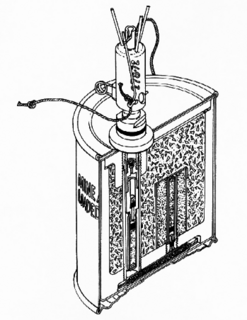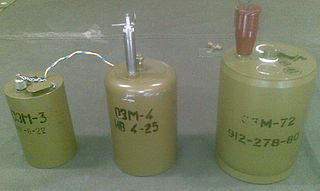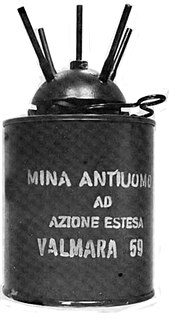Related Research Articles
The GATOR mine system is a United States military system of air-dropped anti-tank and anti-personnel mines developed in the 1980s to be compatible with existing cluster dispensers. It is used with two dispenser systems—the Navy 230 kg (500 lb) CBU-78/B and the Air Force 450 kg (1,000 lb) CBU-89/B. Additionally the mines are used with the land- and helicopter-based Volcano mine system.

An anti-tank mine is a type of land mine designed to damage or destroy vehicles including tanks and armored fighting vehicles.

Valmara 69 or V-69 is an Italian bounding anti-personnel mine manufactured by Valsella. The mine was developed from the V-59 mine, and although the mine is no longer produced in Italy, a number of copies were produced in other countries e.g. the "SPM-1" manufactured by Singapore.

The MON-50 is a claymore shaped, plastic bodied, directional type of anti-personnel mine designed and manufactured in the Soviet Union. It is designed to wound or kill by explosive fragmentation. The mine first entered service in 1965 and is similar to the American M18 Claymore with a few differences.

The MON-90 is a claymore shaped, plastic bodied, directional type of anti-personnel mine designed and manufactured in the Soviet Union. It is designed to wound or kill by fragmentation. The mine is similar in appearance to the MON-50, but is approximately twice the size with a much greater depth.

The M16 mine is a United States-made bounding anti-personnel mine. It was based on captured plans of the World War II era German S-mine and has similar performance. The mine consists of a cast iron body in a thin steel sleeve. A central fuze well on the top of the mine is normally fitted with a pronged M605 pressure/tension (tripwire) fuze. Sufficient pressure on the prongs or tension on an attached tripwire causes the release of a striker. The freed striker is forced into a percussion cap which ignites a short pyrotechnic delay. The purpose of this delay is to allow the victim to move off the top of the mine, to prevent its upward movement from being blocked. Once the delay has burned through, a 4.5-gram black powder charge is ignited, which launches the inner iron body of the mine up into the air. The charge also ignites a second pair of pyrotechnic delays.

The PROM-1 is a Yugoslavian manufactured bounding anti-personnel mine. It consists of a cylindrical body with a pronged fuze inserted into the top of the mine. It is broadly similar in operation to the German S-mine.

The OZM-3, OZM-4 and OZM-72 are Soviet manufactured bounding type anti-personnel mines. (fragmentation-barrier mine, in the Russian and other post-Soviet armies as informally called "frog mine" or "witch" )

The PMN series of blast anti-personnel mines were designed and manufactured in the Soviet Union. They are one of the most widely used and commonly found devices during demining operations. They are sometimes nicknamed "black widow" because of their dark casings.
The M7 is a small, metal-cased United States anti-tank blast mine that was used during the Second World War. It was based on the British Hawkins grenade. Approximately 2.5 million were produced before production ceased, and although it has long since been withdrawn from U.S. service, it can be found in Angola, Burma, Cambodia, Chad, Eritrea, Ethiopia, Korea, Lebanon, Myanmar, Somalia, Thailand, and Zambia.

The M19 is a large square plastic cased United States anti-tank blast mine. Intended to replace the M15 mine, the design dates from the mid-1960s and contains only two metal components: the copper detonator capsule and a stainless steel firing pin which weighs 2.86 grams. It is a minimum metal mine, which makes it very difficult to detect after it has been emplaced. This mine is produced under licence in Chile, South Korea and Turkey. A copy is produced in Iran. It is found in Afghanistan, Angola, Chad, Chile, Cyprus, Iran, Iraq, Jordan, South Korea, Lebanon, the Western Sahara, and Zambia.

The Valmara 59 is a large cylindrical Italian bounding anti-personnel mine. It is the first in the "Valmara" family of mines produced by Valsella Meccanotecnica, and was followed by the Valmara 69 and VS-JAP. The mine's body is plastic with a distinctive five-pronged metal head. The central prong has a hole, to allow the threading a trip wire. The inner body of the mine has a main charge surrounded with approximately 1,000 steel cubes, below which is a steel wire connecting it to the base of the mine. When the mine is triggered a small charge launches the mine into the air approximately 45 cm before the steel wire is pulled taut, the jolt of which pulls a striker into the detonator. A secondary time fuse triggers the mine after three seconds if it has not detonated after being triggered.

The VS-JAP is an Italian bounding anti-personnel mine. It is the latest of the Valmara family of bounding mines that includes the Valmara 59 and Valmara 69. The mine has a waterproof plastic faceted cylindrical body with a three-pronged cap, with a central fixing point for a tripwire. The fuze is triggered via downward or sideways pressure.
The T-AB-1 is a rectangular plastic cased Brazilian anti-tank blast mine. The mine uses a T-AB-1 anti-personnel mine as a fuze. The AP mine is inserted into the body of the AT mine under a large stiff ABS plastic pressure plate. The pressure plate is fastened in place by a number of shear pins, which are designed to give way under a pressure of 200 kg. The AP mine under the pressure plate is then triggered, triggering the mine's main charge.
The NR-413 is a Belgian trip wire activated anti-personnel stake mine. The main body of the mine is wine bottle shaped, with an NR 410 tripwire fuse screwed into a fuse well on the top of the mine. Under the fuse well is a detonator and a row of booster pellets. Wrapped around the detonator and booster pellets is the main charge. An internally square cross-sectioned steel wire is coiled around the outside of the mine, which give a fragmentation effect. The mine produces 600 fragments with a velocity of approximately 1,660 metres per second. It has an effective range of around 15 metres. A variant is produced with a cast steel fragmentation jacket.
The MBV-78-A2 is a small cylindrical Vietnamese anti-personnel fragmentation stake mine. It is unrelated to the MBV-78-A1. The mine has a large plastic head which contains the main charge wrapped around the detonator. A fragmentation layer of steel pieces set into wax surrounds the main charge. The plastic head has two mounting lugs for stake mounting the mine. A Vietnamese copy of the Russian MUV fuze is typically used with the mine, although other fuzes could be used.
The NO-MZ 2B is a Vietnamese anti-personnel fragmentation mine. The mine has a simple cylindrical metal body, with an MUV fuze screwed into the top of the mine. The main charge is surrounded by a number of steel fragments embedded in wax.

The M2 is a United States bounding anti-personnel mine used during World War II. A number of variants of the mine were produced and although the mine is no longer in US service, it can be found in Cyprus, Iran, Iraq, Korea, Laos, Oman, Rwanda, Tunisia and the Western Sahara. Copies of the mine were produced by Belgium, Pakistan (P7), Portugal (M/966) and Taiwan.
The Mini MS-803 is a small South African produced Claymore type landmine. The design is very simple, with a convex brown polystyrene case containing a PE9 plastic explosive charge with three hundred 6 x 8 millimeter cylindrical steel fragments embedded into it. The mine is supported by two pairs of wire legs, which can be used to stack the mines. On the top of the mine is a small hole for inserting a detonator, which is surrounded with a PETN booster charge. The mine is normally used with an S4 electrical detonator connected to an M57 electrical firing device which is also used with the similar but larger Shrapnel mine Mk 2. The mine could also be used with MUV type pull detonators and tripwires, but after the Ottawa mine ban treaty South Africa has said that it will not use this mine with victim activated fuses.
The BM/85 is an Italian blast resistant bounding anti-personnel mine that was produced by Tecnovar italiana SpA. The mine is cylindrical with a three pronged tilt/pressure fuze on the top with a central post for attaching a tripwire. A plastic safety clip prevents the fuze from tilting when in transit. Once the pressure clip is removed the mine is armed. Once the fuze is pulled sideways by a trip wire or by downward pressure, the mine is triggered. A small charge launches the mine to a height of about 0.45 meters where it explodes scattering 1,000 fragments to a lethal radius of about 25 meters.
References
- Jane's Mines and Mine Clearance 2005-2006
- Brassey's Essential Guide to Anti-Personnel Landmines, Eddie Banks
- M432 mine at ORDATA